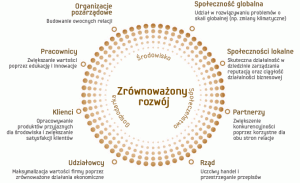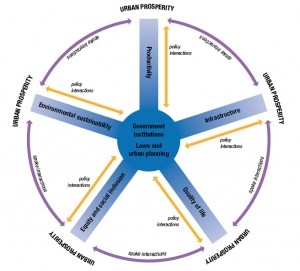The explanation of what is and what is not sustainable development comes down to the following statement: Let’s live so that we don’t put future generations at risk of living in a degraded environment and paying off our debts. Here is an elaboration of that challenge.
Sustainable development is a very broad term. It is addressed in different contexts by economists, politicians and ecologists. It appears in debates on access to water, biodiversity and human rights. Agriculture, urban transportation system or tourism – all can be sustainable. Reference to sustainable development can be found in international documents on the national level, e.g. in constitutions, as well as in local development strategies in small Polish communes. So what is the sustainable development and how does it apply to us?
Fish and sustainable developmet
Let’s picture a village by the lake. Local residents live off fishing which brings sufficient income. The village expands, families grow, and consequently, needs get bigger too. Fishermen invest in better fishing cutters and nets. Competition is getting stronger and stronger. Fishing is not controlled in any way – everyone wants to maintain the family and earn money. With time, problems appear. Oil leaking from damaged cutters cause water pollution. Frequent fishing translates into decreasing amount of fish. Income goes down. More and more families leave the village to search for another place to live and work. The lake – once a potential source of livelihood, has become another polluted basin without fish.
What went wrong? Could the situation be prevented?
In this example three factors overlap: economic (need of an income source), social (maintaining a decent level of life for the fishermen and their families, access to jobs, education, security, housing) and a limited natural resource, i.e. fish in the lake. The fishermen developed expansively. Prosperity and economic development was measured mainly through notable benefits in the form of income from selling fish. Irrational and ineffective use of resources caused the depletion of fish. The bottom line is that in the long term the financial situation of the present generation has not been improved, not to mention future generations. Economic problems triggered gradual worsening of the social situation (impoverishment, growing crime rates, poor access to the job market), which in turns triggered migration.
The problem of the fishing village shows locally problems that started in 1970s on the global scale. It was the time when economists, politicians and ecologists started to think of a vision and the definition of the development that would improve the quality of life while providing the rational use of limited natural resources.
The principles and aims of sustainable development
Sustainable development aims to integrate activities in the following domains:
1) economic growth and share of benefits – sustainable development seeks to fulfill financial needs as well as to level the pace of economic growth in different regions in the world. The economic growth is not a goal in itself anymore. It has become a tool to combat poverty. At the same time, it has to account for limiting the negative impact on the natural environment, e.g. by innovations or new business models focused on cost reduction.
2) social development – the aim of sustainable development is good quality of life for all people – today and tomorrow. Every human being in the world enjoys the right to posses tools and shape their own future and self-realization. Access to water, energy, education, work, health care, preserving cultural and social diversity should be a measure of development. Sustainable development can be achieved only by people who enjoy a certain level of life, sense of security and influence on decisions regarding their environment.
3) natural resources – natural and cultural resources in global and local scale can be depleted one day. They are non renewable or with limited self-regeneration abilities. Yet, they are the key to economic and social growth. One of principles of the sustainable development is stopping the degradation of the natural environment, preservation of resources, rational use of the resources by increased effectiveness thanks to new technologies, renewable energy resources etc.
Therefore, the idea of sustainable development is not about limiting one of the above mentioned factors for the sake of another (e.g. preserving natural environment at the expense of social development of inhabitants in a given region), but finding a balance between the two.
Sustainable development in definitions
Sustainable development has been defined in a number of ways. The first definition appeared in 1987 in the report of the the World Commission on Environment and Development, a.k.a. Brundtland Report, after the Norwegian Prime Minister, Gro Harlem Brundtland, who chaired the Commission.
„ Sustainable development is the kind of development that meets the needs of the present without compromising the ability of future generations to meet their own needs.”
The definition refers to the economic and social growth of the population including such challenges as poverty, human rights, education and health. However, it stresses the need to use natural resources rationally: clean air, water, woods and oil, so that future generations can enjoy them too. In practice it means that our right to development cannot be enjoyed at the expense of neither other people, not the natural environment. It is our responsibility to make this right available to next generations.
A more specific definition which helps to put the principle of sustainable development into the Polish practice can be found in the Environmental Protection Act of 2001: “[it is] a social and economic growth in which political, economic and social activities are integrated, the balance in natural environment and sustainability of natural processes are kept in order to guarantee the opportunity for today’s and tomorrow’s generations of communities and citizens to fulfill their basic needs.”
Sustainable development in historical terms
The debate on human right to live in the environment whose quality ensures dignity and well-being started in 1972 at the Stockholm Conference on natural environment challenges in the global scale. In the same year the Club of Rome published its report “Limits to Growth”. It stressed e.g. depletion of natural resources which are the fundaments of the economic growth.
In 1983 the World Commission on Environment and Development was set up. In 1987 it published its report called “Our common future” which included the above mentioned definition of sustainable development.
In 1992 UN Summit was held in Rio de Janeiro during which a declaration on natural environment and development was adopted. Also, a global action plan Agenda 21 was drafted.
Agenda 21 is an extensive document with guidelines for international communities, governments, social groups and organizations to implement the principles of sustainable development into a local ground. It addresses issues of poverty, promotion of healthy life and health care, sensitive ecosystems management, protection of seas and oceans and preservation of biodiversity. One chapter of Agenda 21 is devoted to the role of local social groups, NGOs, business and industry in sustainable development. The document was signed by 172 countries, including Poland.
Another milestone event strictly connected with sustainable development was defining Millennium Development Goals (MDG in 2000) and the Earth Summit in Johannesburg in 2002.
In 2012 another Summit took place in Rio de Janeiro (Rio + 20) which addressed the issues of environment-friendly economies as tools to combat poverty, protect seas and oceans against excessive exploitation, promote sustainable agriculture, food safety, creation of sustainable and better functioning urban organisms. During the summit a document called “The future we want” was adopted. It recognizes poverty as one of key challenges to be handled by the international community. An importance of sustainable agriculture as a tool to combat famine was underlined. Other issued included in the agenda included access to water, sustainable energy, sustainable transport and sustainable tourism. Critics who assessed the summit outcomes pointed out impractical dimension of the adopted resolutions and departing from specific and concrete obligations.
Sustainable development and I
In the context of an individual, sustainable development comes down to the principle „think globally, act locally” which refers to our personal responsibility for actions taken and disregarded. Every person who takes everyday decisions can contribute to the implementation of sustainable development principles. It can refer to daily shopping (limiting excessive consumption) or choosing a more sustainable means of transportation. It can simply happen while deciding on the shape and direction of the development of our nearest surroundings.
Katarzyna Zaremba
Useful links:
Morżoł I., UNESCO a zrównoważony rozwój, http://www.unesco.pl/edukacja/dekada-edukacji-nt-zrownowazonego-rozwoju/unesco-a-zrownowazony-rozwoj/;
Szadziewska A, Przejawy realizacji koncepcji rozwoju zrównoważonego w działalności przedsiębiorstw, w: Prace i Materiały Wydziału Zarządzania Uniwersytetu Gdańskiego nr 4, tom VI, Sopot 2010, http://zif.wzr.pl/pim/2010_4_4_12.pdf;
42/187.Report of the World Commission on Environment and Development, 1987, http://www.un.org/documents/ga/res/42/ares42-187.htm;
Ustawa z dnia 27 kwietnia 2001 roku, Prawo ochrony środowiska, (Dz.U. nr 62, poz. 627);
Strategia zrównoważonego rozwoju Polski do roku 2025, http://www.nape.pl/Portals/NAPE/docs/akty_prawne/strategie/strategie/Strategia_zrownowazonego_rozwoju_2025.pdf.
This material has been published thanks to the financial support of the National Fund for Environmental Protection and Water Management. The sole responsibility for its contents lies with Collegium Mazovia.







Leave a Reply
You must be logged in to post a comment.